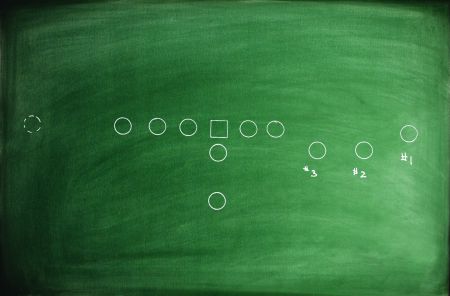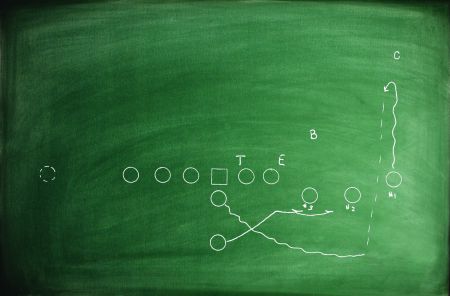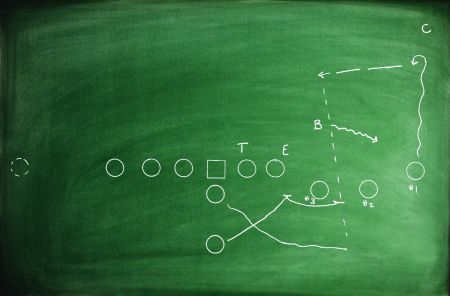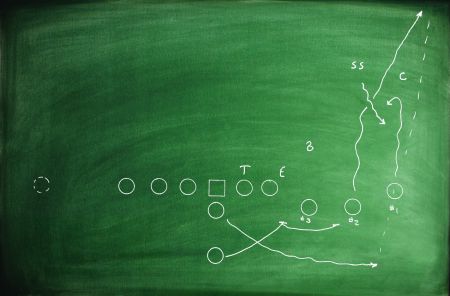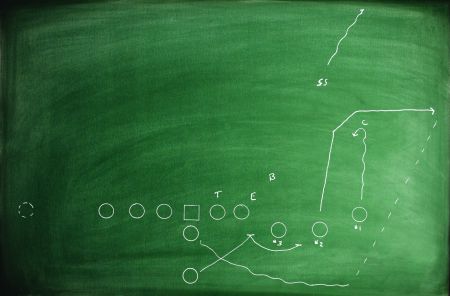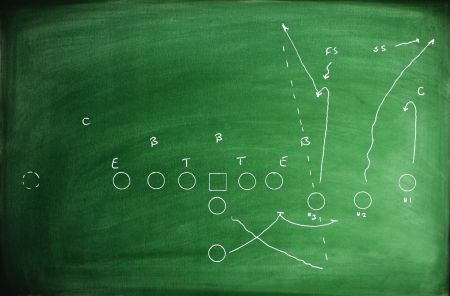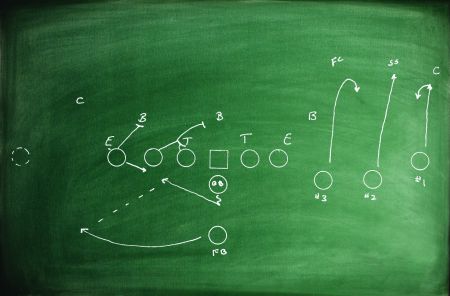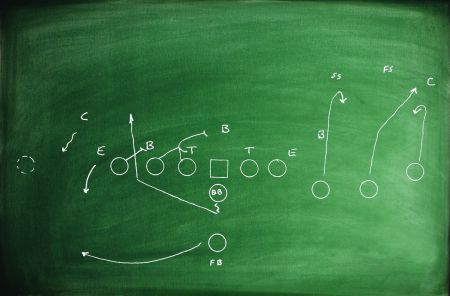Article CategoriesAFM Magazine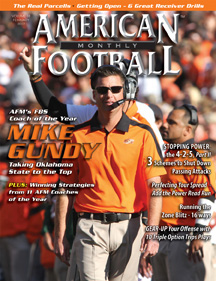
|
The Triple Option Trips Offense – Mixing and matching the routes and timing of three receivers can lead to an explosive offense.by: Mike McDanielsFormer High School Coach, Rockford (IL) © More from this issue In our offensive package, our trips series is one of our most successful and explosive schemes. It is easy to teach as well as execute, and it will enable you to take advantage of whatever tactics the defense tries to employ to stop your momentum. Our basic trips formation positions three receivers to one side of the set, with a tight end or split receiver on the opposite side. The split receiver, #1, is approximately 12-15 yards from the offensive tackle. Our #2 and #3 receivers are in the slot, positioned 5 yards apart and off of the line of scrimmage (See Diagram 1).
Diagram 1. Basic Trips Formation We always begin this series by giving each receiver one basic pattern, along with a read they must make. These reads depend on the coverage and responsibilities of the defender. In order to make it easier for us to exploit the coverage, we use roll-out passing. This allows us to put maximum pressure on the defensive corner as well as perimeter run support. To begin this series, our #1 receiver has one basic pattern, along with a read they must make. Our (#1) receiver executes a 10-12 inside curl. Once he has turned inside, he keys the outside linebacker. If the linebacker does not attempt to maintain containment, our split receiver will stay in his initial position for the pass or become a blocker if the QB decides to run the ball himself (See Diagram 2). In the event that the linebacker’s responsibility is to maintain outside control or cover the flats area, our #1 receiver will move into the linebacker’s unoccupied area (See Diagram 3).
Diagram 2. Keying on the Linebacker
Diagram 3. LB Covers the Flats By utilizing this option, you will find that the #1 receiver is open on almost every play. No matter what the linebacker’s responsibilities are, this scheme will reduce his effectiveness. The #1 receiver will usually be open in the event that the QB has to get rid of the ball in a hurry. The positioning of our #2 receiver and the pattern he runs accounts for more touchdown passes than any other position. His basic pattern is the corner route. Once again, he is responsible for making his read. His key is the strong safety. Since we don’t know what type of secondary rotation we will be facing, he has to make a more complicated decision. As soon as the #2 receiver leaves the line of scrimmage, he keys the near safety. If the safety is coming up into the flats, the receiver will head to the corner immediately. This pattern is set up as a result of the inside curl pattern by the #1 receiver. The defensive corner will freeze momentarily, locking up with the curl pattern. By the time the corner realizes that he has the deep third, it is too late (See Diagram 4).
Diagram 4. Keying the Strong Safety This tandem creates a natural pick, and if the corner stays at home and covers the curl route, the #2 receiver will be wide open. If he takes the deep one-third, the curl is wide open. Lastly, if he stays in between the two receivers, he is limited to assist in run support. After being exploited several times by this sequence, the defense will have to cover this play by having the strong safety cover the deep outside one-third. Once our #2 receiver sees the safety rotating to his position, our receiver will break the corner pattern and head straight for the sideline (See Diagram 5).
Diagram 5. Safety Rotates to His Position As this route develops, the #2 receiver will eventually become wide open as he continues running outside of the #1 receiver’s curl route. Both patterns are extremely difficult to cover because of the additional reads that our receivers are able to make. While the #1 and #2 receivers are executing their patterns and making their reads, our #3 receiver’s pattern and read will depend on the positioning of the (FS) free safety. We have seen the FS line directly in front of the #3 receiver, as well as positioning himself directly in line with the QB. If the FS is directly in front of the QB, the #3 receiver will execute a 10-12 yard curl. Once again, the receiver will be wide open (See Diagram 6).
Diagram 6. Receiver Executes a Curl Once this pass has been completed several times, the FS will have to position himself head up on the #3 receiver. Since we have completed several passes into the curl area and are waiting for the FS to move over in order to defend the curl, we will adjust the #3 receiver’s pattern. At this time we will have the #3 WR run a curl and go pattern to the post (See Diagram 7).
Diagram 7. Receiver Runs a Curl and Go Pattern Because of the roll-out protection and the ability of the QB to run with the ball, we seldom see man-to-man coverage used against this scheme. If we do see man-to-man coverage, we will immediately send all three receivers deep. This will tell the QB to run the ball because of the limited run support from the secondary. When facing man-to-man coverage, we will also use motion from our receivers as well as our solo running back. If the defense decides that they are going to sink or swim with man-to-man coverage vs. the trips, we will start running the speed option to the TE side or we will motion the fullback outside of the TE and have the TE run a corner or fly pattern. To execute the speed option, our QB takes a two-step drop as to pass the ball. He then runs directly at the last defender on the line of scrimmage, which is normally a defensive end on the TE side. If the defender takes the QB, the QB will pitch the ball to the trailing FB (See Diagram 8). If the defensive end steps outside to maintain pitch control, the QB will keep the ball himself and run inside of the defensive end (See Diagram 9).
Diagram 8. QB Pitches
Diagram 9. QB Keeps the Ball When putting the FB in motion to the TE side, we want him to run as far outside the TE as possible, drawing the defensive corner with him. This will open up a natural alley for our TE to execute his corner or fly pattern. When executing this play, the QB takes a two-step drop, turns and looks momentarily at the motion back. He then repositions himself and throws to the TE (See Diagram 10).
Diagram 10. Delay Pass to the TE This is a very short and simple package that you may want to put into your offensive arsenal. It is important to teach your athletes why they are running a specific pattern and why their reads are so important. As you implement this scheme into your practice, you will realize that there is always at least one receiver open in every play. You will also realize that the defense cannot afford to overload the trips side. There are at least two equally successful plays, the speed option and the TE corner route, that you may use away from the trips. This scheme, once implemented, will give you a tremendous advantage over your opponent. The counter measures built into the receiver’s pattern and reads puts the defense into a no-win situation. |
|
| HOME |
MAGAZINE |
SUBSCRIBE | ONLINE COLUMNISTS | COACHING VIDEOS |
Copyright 2024, AmericanFootballMonthly.com
All Rights Reserved


